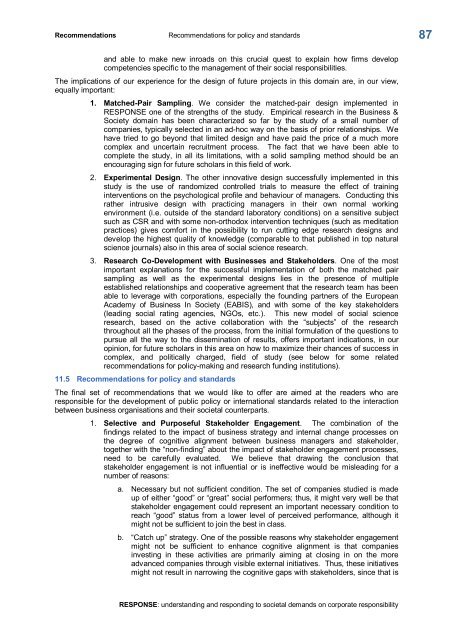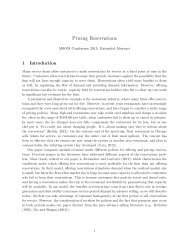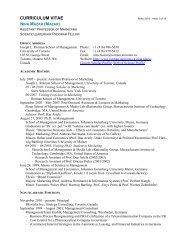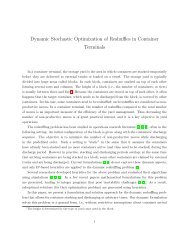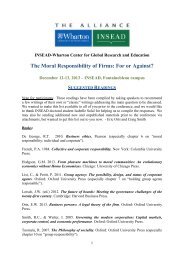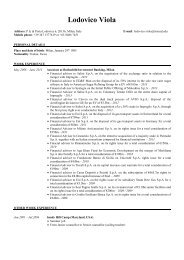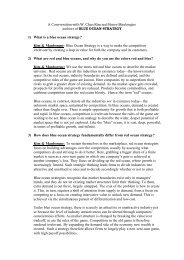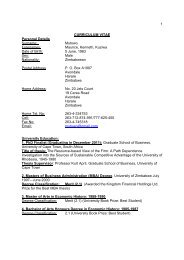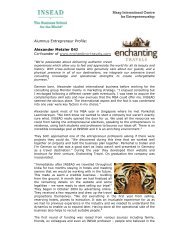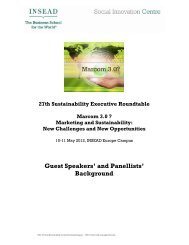RESPONSE - Insead
RESPONSE - Insead
RESPONSE - Insead
You also want an ePaper? Increase the reach of your titles
YUMPU automatically turns print PDFs into web optimized ePapers that Google loves.
Recommendations Recommendations for policy and standards<br />
and able to make new inroads on this crucial quest to explain how firms develop<br />
competencies specific to the management of their social responsibilities.<br />
The implications of our experience for the design of future projects in this domain are, in our view,<br />
equally important:<br />
1. MatchedPair Sampling. We consider the matchedpair design implemented in<br />
<strong>RESPONSE</strong> one of the strengths of the study. Empirical research in the Business &<br />
Society domain has been characterized so far by the study of a small number of<br />
companies, typically selected in an adhoc way on the basis of prior relationships. We<br />
have tried to go beyond that limited design and have paid the price of a much more<br />
complex and uncertain recruitment process. The fact that we have been able to<br />
complete the study, in all its limitations, with a solid sampling method should be an<br />
encouraging sign for future scholars in this field of work.<br />
2. Experimental Design. The other innovative design successfully implemented in this<br />
study is the use of randomized controlled trials to measure the effect of training<br />
interventions on the psychological profile and behaviour of managers. Conducting this<br />
rather intrusive design with practicing managers in their own normal working<br />
environment (i.e. outside of the standard laboratory conditions) on a sensitive subject<br />
such as CSR and with some nonorthodox intervention techniques (such as meditation<br />
practices) gives comfort in the possibility to run cutting edge research designs and<br />
develop the highest quality of knowledge (comparable to that published in top natural<br />
science journals) also in this area of social science research.<br />
3. Research CoDevelopment with Businesses and Stakeholders. One of the most<br />
important explanations for the successful implementation of both the matched pair<br />
sampling as well as the experimental designs lies in the presence of multiple<br />
established relationships and cooperative agreement that the research team has been<br />
able to leverage with corporations, especially the founding partners of the European<br />
Academy of Business In Society (EABIS), and with some of the key stakeholders<br />
(leading social rating agencies, NGOs, etc.). This new model of social science<br />
research, based on the active collaboration with the “subjects” of the research<br />
throughout all the phases of the process, from the initial formulation of the questions to<br />
pursue all the way to the dissemination of results, offers important indications, in our<br />
opinion, for future scholars in this area on how to maximize their chances of success in<br />
complex, and politically charged, field of study (see below for some related<br />
recommendations for policymaking and research funding institutions).<br />
11.5 Recommendations for policy and standards<br />
The final set of recommendations that we would like to offer are aimed at the readers who are<br />
responsible for the development of public policy or international standards related to the interaction<br />
between business organisations and their societal counterparts.<br />
1. Selective and Purposeful Stakeholder Engagement. The combination of the<br />
findings related to the impact of business strategy and internal change processes on<br />
the degree of cognitive alignment between business managers and stakeholder,<br />
together with the “nonfinding” about the impact of stakeholder engagement processes,<br />
need to be carefully evaluated. We believe that drawing the conclusion that<br />
stakeholder engagement is not influential or is ineffective would be misleading for a<br />
number of reasons:<br />
a. Necessary but not sufficient condition. The set of companies studied is made<br />
up of either “good” or “great” social performers; thus, it might very well be that<br />
stakeholder engagement could represent an important necessary condition to<br />
reach “good” status from a lower level of perceived performance, although it<br />
might not be sufficient to join the best in class.<br />
b. “Catch up” strategy. One of the possible reasons why stakeholder engagement<br />
might not be sufficient to enhance cognitive alignment is that companies<br />
investing in these activities are primarily aiming at closing in on the more<br />
advanced companies through visible external initiatives. Thus, these initiatives<br />
might not result in narrowing the cognitive gaps with stakeholders, since that is<br />
<strong>RESPONSE</strong>: understanding and responding to societal demands on corporate responsibility<br />
87


